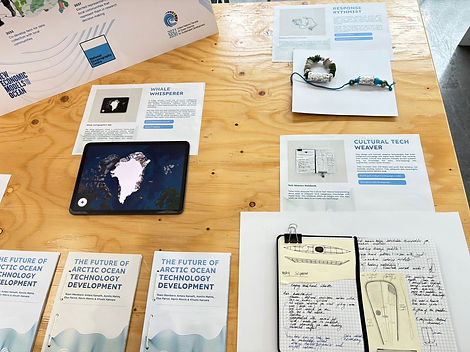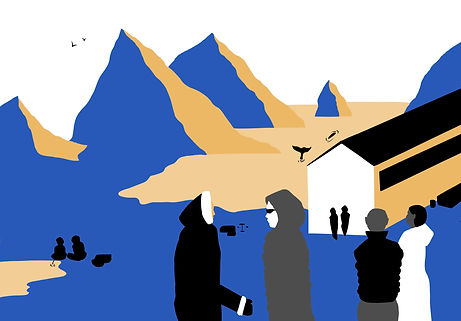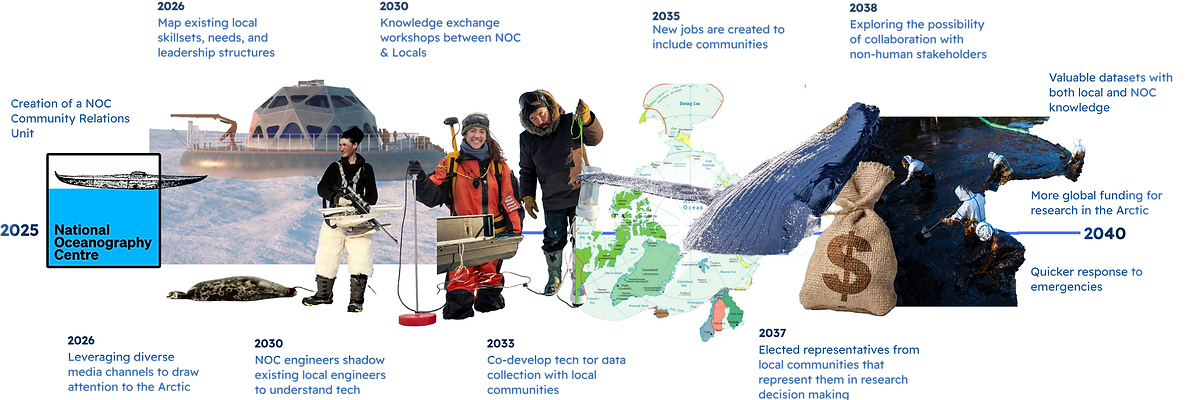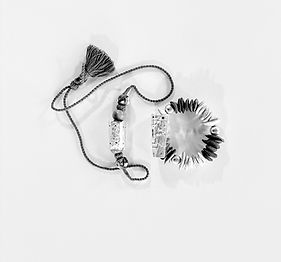
The Future of Ocean Technology Development in the Arctic
Design Sprint
Collaborators

Antara Kamath, Elsa Parrot, Kevin Morris and Khushi Kansara







As interest in the Arctic grows, the focus is shifting from extraction to exploring what we don’t yet know, including what lies beneath the ice. NOC’s ambitions include sending autonomous vehicles under Arctic ice to answer fundamental questions about biogeochemistry, ecosystems, and climate.Yet Arctic science also raises critical questions: Who owns the knowledge produced? How do we ensure it is open, useful, and shared, especially with communities living closest to the change?

Discover & Define
Horizon Scanning
Expert Interviews

Strategise
2x2 Scenarios

Develop
Three Horizons Framework
Backcasting

Deliver
Future Artefacts
Horizon Scanning
We conducted horzion scanning to identify key trends and drivers in the space. These were validated through our conversations with engineers and scientists at NOC.

Utilising traditional knowledge from local communities

Involving indigenous communities in policy decision making

Increased number of ships in the arctic due to melting ice

Using stories to increase research ocean awareness

Digital Twins of the ocean to help design better AUV’s

Knowledge of animal behaviour can make research efforts more effective
Scenario Planning
The graph has two axes: global funding (increasing to decreasing) on the horizontal axis, and local community involvement (active to passive) on the vertical axis.
We used this 2x2 approach to help us define four distinct scenarios for the future of ocean technology development in the Arctic, shaped by the evolving interactions between these key factors.

Co-Arctic Commons
The Arctic emerges as a model of resilient, culturally grounded stewardship, where technology as we know it is redefined through Indigenous knowledge systems.
Rather than bringing solutions in, engineers and researchers learn from the sophisticated technologies already embedded in the Arctic way of life, technologies that are deeply adaptive to the environment and shaped by generations of lived experience, as well as from other species that exist and thrive in this environment.
Research funding shifts toward supporting and amplifying these existing methods, improving data collection and emergency response through tools that align with local epistemologies rather than override them.Decision-making remains grounded in Arctic communities, with external actors stepping into roles of support and observation. The result is a revitalised economy driven by Indigenous leadership, where global understanding grows not through intervention, but through humility, respect, and learning. The Arctic is no longer seen as a blank frontier, but as a sovereign, thriving region shaping its own future.

Autonomous Arctic
The Arctic emerges as a model of resilient, culturally grounded stewardship, where technology as we know it is redefined through Indigenous knowledge systems.
Rather than bringing solutions in, engineers and researchers learn from the sophisticated technologies already embedded in the Arctic way of life, technologies that are deeply adaptive to the environment and shaped by generations of lived experience, as well as from other species that exist and thrive in this environment.
Research funding shifts toward supporting and amplifying these existing methods, improving data collection and emergency response through tools that align with local epistemologies rather than override them.Decision-making remains grounded in Arctic communities, with external actors stepping into roles of support and observation. The result is a revitalised economy driven by Indigenous leadership, where global understanding grows not through intervention, but through humility, respect, and learning. The Arctic is no longer seen as a blank frontier, but as a sovereign, thriving region shaping its own future.

Deep Sea Race
Flooded with capital but with no context of what is required, the Arctic becomes a battleground for technological competition. Corporations and political powers race for dominance, extracting data and resources with little regard for the lives and knowledge of local communities.
Though the region sees a surge in tech, it’s implemented without understanding, leading to unintended harm to biodiversity and local ways of life.
Traditional knowledge is sidelined, and locals become passive recipients of tools they didn’t ask for and cannot shape. The Arctic is rich in research but poor in representation, its identity overwritten by global ambition and extractive practice which eventually leads to a downfall of environmental condition.


Echoes of the Past
The Arctic ends up being remembered as a place that lost more than it preserved. Traditional communities are sidelined and under-funded technologies fail to respond to the environmental crisis that the arctic is facing. These data extraction tools not only lack context, but also lacks significant global collaboration as there simply isn't enough funding to see it through.
Data gaps widen, weakening emergency response and leaving the region vulnerable to rising waters and disappearing ecosystems. The result is a disconnected, destabilised landscape where climate action arrives too late.
Roadmap
We used the three hozions and backcasting framework to create a strategy roadmap to achieve the preferred future scenario- Co Arctic Commons.

Artefacts
We envisioned what the future might look like in a co-arctic commons scenario where technology and research is led by the indigenous community. In this scenario, we are able to learn from the lived experience of these locals and individuals have different roles that help us better understand the arctic.
Signal Scout
A vigilant observer embedded in Arctic ocean, tundra, or ice shelf where they interpret environmental cues. By bridging seasonal rhythms with formal oceanographic data, they help scientists interpret ocean changes through indigenous seasonal calendars, not just metrics.
The signal scout uses their glasses not only as a tool to protect from glare but it combines local technology with technology from the rest of the world like augmented reality graphics and AI powered observation. This helps them utilise their existing knowledge, just more efficiently than they did before as this tech enhances their perception capabilities without completely changing the data collection method.
Multisensory Data Interpretation
AI Observation Tools Expertise

Signal Scout’s Smart Glasses
Whale Whisperer
A bridge between human and non-human intelligences. Specializing in species such as whales, caribou, and seabirds, they decipher vocalizations, migratory shifts, and body language to inform seasonal planning, navigation, and climate forecasting.
They help refine tech tools (hydrophones, tracking devices) to be less invasive and more harmonious with animal behavior, reducing ecological disturbance. They maintain trust relationships with key animal populations and identify stress indicators. They support cross-species emergency alerts.
The Whale Whisperer utilizes a customized marine-grade tablet, embedded with an AI-enhanced mapping system, designed specifically for decoding and visualizing whale migration routes through real-time song analysis.
This knowledge is not proprietary- it is collectively stewarded by Indigenous communities, local fishers, and climate researchers.
Animal Relationship Stewards
Acoustic Mapping

Whale Cartographer's App
Response Rhythmist
A community-embedded responder who activates during ecological or social emergencies (blizzards, sea ice shifts, or health crises). Rather than top-down command, they synchronize response through rhythm—coordinating humans, animals, and systems using drum signals, light pulses, and oral messaging.
They help NOC teams understand risk and resilience through non-linear time, integrating oral history and rhythmic planning. They use oral traditions and modern mapping to guide safe pathways and train the youth in multi-temporal response systems.
The bracelet senses environmental changes and guides users through pulses on the wrist, enabling navigation without sight. It blends traditional knowledge with real-time data and allows silent communication across Arctic distances.
Emergency Navigation
Pulse Based Communication

Pulse Communication Bracelet
Cultural Tech Weaver
They design and maintain adaptive technologies that braid Indigenous knowledge with digital tools. Rather than creating from scratch, Cultural Tech Weavers translate ancient systems (e.g., ice knowledge, fish weirs, time-keeping) into augmented, context-aware formats. They co-create tools with Elders and youth that enhance, not override, existing systems. They safeguard data sovereignty, ensuring control remains local.
These notes showcase the Cultural Tech Weaver brainstorming about ways to integrate local indigenous knowledge with digital tools. This notebook offers an insight into how they could use these ideas to co-create new technology.
Multilingual (Indigenous language + code)
Eco-centric tech development

Tech Weavers Notebook